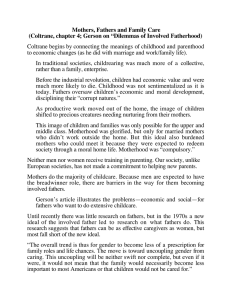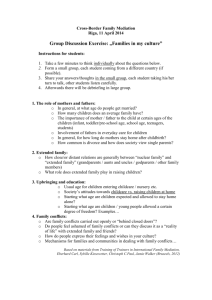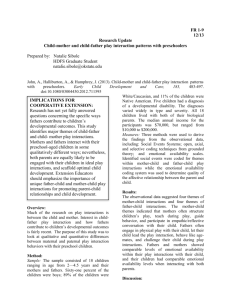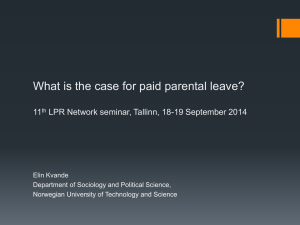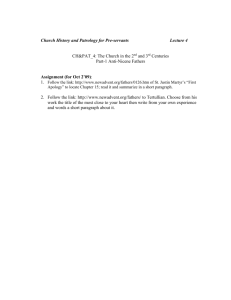CHORE WARS I Men are now pulling
advertisement
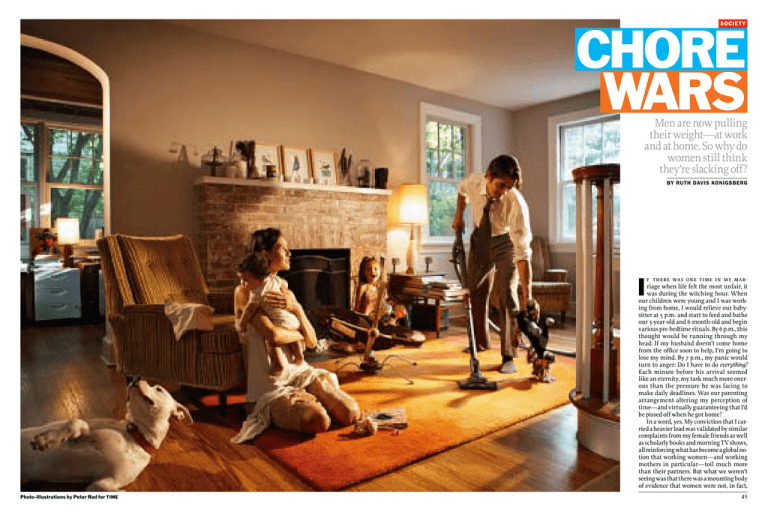
society CHORE WARS Men are now pulling their weight—at work and at home. So why do women still think they’re slacking off? By Ruth davis konigsberg I f there was one time in my marriage when life felt the most unfair, it was during the witching hour. When our children were young and I was working from home, I would relieve our babysitter at 5 p.m. and start to feed and bathe our 3-year-old and 6-month-old and begin various pre-bedtime rituals. By 6 p.m., this thought would be running through my head: If my husband doesn’t come home from the office soon to help, I’m going to lose my mind. By 7 p.m., my panic would turn to anger: Do I have to do everything? Each minute before his arrival seemed like an eternity, my task much more onerous than the pressure he was facing to make daily deadlines. Was our parenting arrangement altering my perception of time—and virtually guaranteeing that I’d be pissed off when he got home? In a word, yes. My conviction that I carried a heavier load was validated by similar complaints from my female friends as well as scholarly books and morning TV shows, all reinforcing what has become a global notion that working women—and ­working mothers in ­particular—toil much more than their partners. But what we weren’t seeing was that there was a mounting body of evidence that women were not, in fact, Photo-Illustrations by Peter Rad for TIME 45 society | domestic divide 46 ‘Maybe men really were all jerks and not doing their fair share, or maybe they were allocating their time to other things.’ —suzanne bianchi, professor of sociology, ucla and unpaid work—which is to say, work at the office and all the drudgery you have to do at home—that were almost exactly the same: 8 hr. 11 min. for men, 8 hr. 3 min. for women. For those who had children under the age of 18, women employed full time did just 20 min. more of combined paid and unpaid work than men did, the smallest difference ever reported. No, men were not doing the same amount of housework as women, but neither were women pulling the same number of hours at the office as men. (Husbands and wives who split everything down the line are as hard to find as the great white whale. In a 2009 analysis of results of the National Study of the Changing Workforce, Scott Hall at Ball State University found that only 9% of 810 people in dual-earner couples split every­ thing. These couples are often parents who do blue collar shift work and cannot afford and are not at liberty to be flexible in their work hours.) What’s more, new research on working fathers indicates that they’re the ones experiencing the most pressure. In a July report called, tellingly, The New Male Mystique, the Families and Work Institute surveyed 1,298 men and concluded that long hours and increasing job demands are conflicting with more exacting parenting norms. The institute had launched the survey to follow up on its 2008 finding that 60% of fathers said they were having a hard time managing the responsibilities of work and family, compared with only 47% of mothers in dual-earner couples. “Men are feeling enormous pressure to be breadwinners and involved fathers,” says Ellen Galinsky, the institute’s director. “Women expect more of men, and men expect more of themselves.” This report comes on the heels of a national survey of 963 fathers working at Fortune 500 companies, conducted by Boston College’s Center for Work and Family and released in June, in which 57% of respondents agreed with the statement “In the past three months, I have not been able to get everything done at home each day because of my job.” Brad Harrington, executive director of the Center for Work and Family, points out that men may be feeling particularly squeezed because they never anticipated having so much domestic responsibility. “It’s a surprise for them. They weren’t prepared that this would be expected of them, and they have no role models of how to do it,” he says. What these new findings mean is that the widespread belief that ­working mothers have it the worst—a belief that ­engenders an enormous amount of conflict between spouses—is simply not the open-and-shut case it once was. ­Q uantitatively speaking, we have no Peter Rad for TIME workhorse wives picking up their husbands’ slack, that there are several variables in the dual-earner equation, debits as well as credits that need to be tallied in order to take a true measure of who does more. So does that mean my sense of injustice and that of so many other women have all been the result of an accounting error? Thankfully, it’s not quite so simple. But the story of how a woman’s double (or was it triple?) ­duty of paid work and housework and child care turned into a foregone conclusion even while the data have been telling us otherwise does begin with some math. When women began to enter the workforce in large numbers in the 1970s, it seemed logical that one day husbands and wives would divide making money and taking care of the home in a 50-50 split. University of Chicago economist Gary Becker’s 1965 theory of the allocation of time predicted it would happen, and he won a Nobel Prize. But that goal, as all of us non-­ Nobelists can attest, proved elusive. Maybe we simply put too much faith in the power of structural change absent family-friendly policies or were too naive about how deeply our gender norms for who does what inside the home were ingrained. At any rate, women joining the workforce soon faced a new challenge: to get their husbands to chip in more with the housework. That sometimes led to fights. No—that almost always led to fights. Women who found partners who ran the dishwasher at night and emptied it in the morning without being asked were viewed as the lucky exceptions. Women who had partners who cleared the table but then dumped the dishes into the sink were the norm. Feminism became known as “the movement that brought women more work,” as the frustrated housewife of the 1950s and ’60s became the equally frustrated wage-earning housewife of the ’70s, ’80s, ’90s and 2000s. And all the bickering about who did what escalated. In a 2007 poll conducted by the Pew Research Center, 62% of married adults said “sharing household chores” was the third most important ingredient (after faithfulness and sex) in a successful marriage—up from 47% in a comparable study in 1990. So a year and a half into a new decade, it may come as a surprise to you, as it did to me, to discover that on balance, husbands and wives have never before had such similar workloads. According to data just released by the U.S. Bureau of Labor Statistics, men and women in 2010 who were married, childless and working full time (defined by the BLS as more than 35 hours a week) had combined daily totals of paid grounds to stand on. And it’s time that women—­myself included—­a dmit it and move on. How men and women divvy up The Work A Tale of Two Sociologists the assumption that working women had become the Clydesdales of contemporary marriage can be traced back to the publication of Arlie Russell Hochs­child’s The Second Shift in 1989. In the 1970s, Hochs­child was a sociologist with two young children who was trying to get tenure at Berkeley, where she saw her male colleagues unencumbered by demands at home and was inspired to write about the working woman’s double day. “It came from my own anguish, my own conflict,” she says. Over the course of 10 years, Hochs­child interviewed 50 couples, spending weeks at a time observing their tensions and resentments, their concessions and compromises. Part of The Second Shift’s power, aside from Hochs­ child’s considerable talents as a writer, was the depth of its qualitative research. But the book, which has enjoyed a long shelf life and is still read on college campuses, made an indelible mark with its famous finding that women worked roughly 15 more hours each week than men. Hochschild came up with that number by averaging data collected in the 1960s, spotlighting what is now clearly the product of a culture in transition, a lag between women’s entry into the workforce and the great domestic shakeout in which working women cut back on housework, often by outsourcing, and men reduced office hours and chipped in more at home. Yet Hochschild’s interpretation of that statistical blip in the 1960s came to define the plight of women in the 1990s and 2000s. The Second Shift was a crossover hit and sparked a huge surge of academic writing on the inequalities of the household, or “domestic-labor literature,” much of it devoted to trying to figure out why men were not picking up more slack. One American sociologist, Suzanne Bianchi, stood on the sidelines of the whymen-aren’t-doing-more debate for many years. From 1978 to 1994, she was a demographer and statistician at the U.S. Census Bureau working with large representative samples that shed light on long-term changes at the population level. Bianchi was looking at almost everything but housework—education,­ earnings, ­changes in employment—so she became aware of the pitfalls of focusing only on the domestic sphere. “Maybe men really were all jerks and not doing their fair share, or maybe they were allocating their time to other Moms with full-time jobs have the largest total workload, logging five more hours a week than dads—and just 10 fewer hours of child care than stay-at-home moms—when kids are under 6. The biggest discrepancy occurs when kids are young paid work child care all other unpaid family work mothers employed full time 73 mothers employed part time 66 nonemployed mothers 58 fathers with wives employed full time 68 fathers with wives employed part time 68 fathers with nonemployed wives 0 10 hours per week 20 30 68 40 50 60 70 total hours Over the decades, a shifting divide Time to stop arguing? Married mothers still do more on the home front and less paid work than married fathers, who have nearly tripled their domestic contributions since 1965 Married men and women with full-time jobs have almost equal total workloads, with or without kids under 18 hours per week married fathers married mothers 1965 1985 2010 food preparation and cleanup 0.9 16 2.2 10.2 2.7 7.6 housework 0.5 15.3 20 1.8 2 9 8.1 2.6 3 6.4 10.6 9.3 12 42.5 40.6 Number of additional minutes of paid and unpaid labor done per day by married moms with full-time jobs and kids under 18, compared with working dads, in 2010 child care 8 paid work 47.8 6 19.7 22.2 Number of additional minutes of paid and unpaid labor done per day by married men with full-time jobs and no kids, compared with working women, in 2010 s o u r c e s : S o c i a l F o r c e s , d e c e m b e r 2 0 0 9 ; 2 0 10 Am e r i c a n Tim e U s e S u r v e y, b u r e a u o f l a b o r s tat i s t i c s; 1 9 6 5 – 6 6 a n d 1 9 8 5 Am e r i c a n s’ u s e o f t im e s t u dy society | domestic divide The Masculine Mystique? Like Betty Friedan’s unhappy housewife, today’s working dad may be suffering from gender idealization, which pressures him to be both breadwinner and involved father. “There are many reasons to be concerned about men,” says Ellen Galinsky of the Families and Work Institute, which just released a report concluding that long hours at work and the blurring of boundaries between the office and home are to blame. That study and other new research show how much dads are feeling squeezed. 48 Lareau of the University of Pennsylvania calls “the concerted cultivation of children,” an attempt to draw out children’s talents with organized activities and groom them for success, which requires a lot of waiting around while they do Taekwondo. This phenomenon—­largely an uppermiddle-class one—is known as intensive parenting, although given the gender breakdown still in play, it would probably be more accurate to call it intensive mothering and involved fathering. Men are doing a lot of child care too—an average of 53 min. a day in 2010 for children under 18, which is almost three times as much as they did in 1965. Working women are doing an average of 1 hr. 10 min. a day, which is only 17 more min., but the compulsory aspect of it may contribute to the feeling of being more time-poor. Picking your child up from day care, for example, or getting a nutritious dinner onto the table cannot be put off until the morning. The group that has benefited the most from women’s entering the workforce is, ironically, stay-at-home mothers, whose husbands are doing more child care as a result of the larger cultural shift toward involved fatherhood and who now stand out as uniquely low in their total workload. Among married couples with children under 6, Bianchi’s analysis shows, non­ employed mothers spend only 10 more hours a week on child care than moms with full-time jobs. “In terms of gender equality, it’s paradoxical that upper-­ middle-­class women have the highest rates of employment and yet they’re the ones that are bearing the biggest brunt of these intensive child-­rearing norms,” says Paula England, a sociology professor at New York University. And they compensate for this larger time commitment to children by scaling back their work hours—from, say, a 45-hour workweek to a 40-hour one. So the first shift decreases, but not in a way that leaves them at liberty. The result is that working women now have a greater perception of being overworked, even as the total workloads of the sexes have been trending toward convergence. Why do we feel we’re doing so much more than our partners? “Some things that you’re orchestrating might not take up a lot of time, but they do take up mental energy,” notes Bianchi, who is now at UCLA. Time diaries don’t take into account the stress women feel from being household managers, keeping that precisely calibrated family schedule in their heads at all times or knowing what’s for dinner, what ingredients are required and their exact location in the refrigerator. The Myth of the Slacker Dad what’s clear from the latest round of data is that men and women alike work hard and feel work-family conflict, although that conflict manifests itself in different ways. “For working fathers, work interferes with family more than family interferes with work,” says Harrington of Boston College’s Center for Work and Family. “They’re working more hours and carrying more responsibility, so it’s natural that they would feel more career pressure.” Harrington also points out that the workplace makes fewer accommodations for fathers than for mothers. “When women come back to work after a baby is born, there’s an expectation that she’ll have to make compromises, but the men in our survey felt that there was no way that their managers expected less of them as a result of having a child. So there’s a conflict between a father’s responsibility to his 72% 57% agree with this statement: ‘In the past three months, I have not been able to get everything done at home each day because of my job.’ 68% have experienced problems with their employer because of conflicts between their job and their duties as a parent report that their income would decline if they worked fewer hours s o u r c e s: Fa mi l i e s a n d W o r k I n s t i t u t e; B o s to n C o l l eg e Center for Work and Fa mi ly; W o r k p l a c e Op t i o n s Peter Rad for TIME things. By isolating housework from other kinds of work, you lost track of the fact that families need money as well as time, and men were doing a lot of that,” she says. “I began to get interested in what we really know. We think men don’t do anything, but is that right? Are we systematically missing what they do do?” When Bianchi left the Census Bureau to teach at the University of Maryland, she teamed up with John P. Robinson, director of the Americans’ Use of Time Project, which collects data (and discourages exaggeration) by having participants account for all 24 hours of their day in a time ­diary. Bianchi and her colleagues analyzed time-­ diary data from 2003 to ’05 and found that among couples in which both partners work full time, men’s greater hours of paid work counterbalanced women’s greater hours of unpaid work. A second shift, where it still existed, was most evident in dual-earner couples with children under the age of 6, but it was a difference of five hours more of combined paid and unpaid work for women a week, not 15. “That didn’t mean that The Second Shift was completely wrong, just that it was misleading,” says Bian­chi, who published her analysis in 2009. “Another thing that got missed was that women shed housework when they’re employed full time, but they hold on to a lot of child care, and that’s a big piece of why The Second Shift resonates so much.” In the past several decades, mothers have actually increased the amount of time spent with their kids, a feat all the more remarkable considering that paid work has meant they’re spending more and more hours outside the home. In addition, how they spend that time with their kids has gotten more labor-intensive as parenting styles have shifted toward what Annette family and to the workplace, there’s a conflict between his spouse’s expectations and what he can deliver, and there’s a conflict between his own career aspirations and being an ideal parent.” All those competing pressures may account for why 65% of working fathers in Harrington’s survey believed that partners should provide equal amounts of care but only 30% of fathers reported that caregiving is actually equal. Researchers are also discovering differences in how men and women experience time, especially free time. Liana Sayer, a sociologist at Ohio State University, and Marybeth Mattingly, now at the University of New Hampshire, found that whereas in 1975 free time reduced feelings of being rushed for men and women alike, by 1998 it no longer reduced time pressure for women. Not only do women report having less free time than men now, but also the quality of that free time has worsened. “We suspect that it has to do with shifts in how women are spending their free time, which is increasingly devoted to a blend of child care and leisure activities,” says time August 8, 2011 Sayer, who notes that this leads to leisure’s being “contaminated” by less pleasurable activities or “fragmented” by interruptions—when you’re reading on the couch, say, and get called away every 15 minutes to referee a squabble or find a missing Lego piece or administer a snack. According to the University of Maryland’s time-diary studies—which, unlike the BLS’s, collected data on tasks occurring simultaneously— in 1975, mothers combined 25% of their child-care activities with leisure activities. By 1998, that had risen to 50%. And even the most dedicated mother would probably admit that there’s a qualitative difference between having an adults-only meal with friends and going out for pizza with those same friends and a bunch of kids. The gender inequity that persists, then, is in access to high-quality leisure time, which, for whatever reasons, men seem more able to claim—and protect from ­contamination—than women. The obvious cost of this leisure deficit is that women have less opportunity to relax in a way that recharges their batteries. This is a real griev- ance that needs to be addressed, but women also have to acknowledge all the work that men are doing and take comfort in the fact that short-term imbalances, especially after childbirth, can—and should—be renegotiated over the course of a marriage, as long as neither partner gets too entrenched in a particular role. For the good news is that the longer a wife stays employed, the more her husband is likely to chip in at home. And the older the kids get, the less time they need. Mothers of 14- and 15-year-olds spend only about 13 min. more a day on unpaid labor than young childless women. Free time increases too—once the kids are all grown up—with mothers of adult children clocking amounts of leisure time similar to those of young women without children. I’ll bet, however, that the moms enjoy it much, much more. Will the notion of the working woman’s second shift ever get laid to rest? It would certainly help if men as well as women would take their feet slightly off the gas pedal of their careers when their children are very young. But the second shift has also become something of an idée fixe, a chronic lament that makes change seem impossible and locks men and women into a perpetual stalemate. As sociologist Joseph Pleck points out, “Inequity in the gender division of labor gets rediscovered in pop culture every seven to 10 years as a new generation of women enters early parenthood and that’s the issue that they see.” As for the book that put a name to the source of this conflict, it too has had several lives. The Second Shift was reissued in 2003 and will be updated and reissued again in January. “Penguin called me up and said, ‘Hey, this is still hot,’” says Hochschild. I came into this story wanting, more than anything else, to find a way to escape the feeling—I was about to say of oppression, but maybe it’s more exhaustion— that I have when I leave work each day and face all that needs to be done at home. I never realized that one solution was staring me in the face: Don’t go home so early! “As long as women pull back on paid work, they enable men not to, so it gets to be a vicious cycle,” says Bianchi. My kids are now out of diapers and go to bed later, and the babysitter stays until 7 p.m. I’m back to working longer hours in an office, which has actually had the biggest impact, more than any amount of asking, pleading, goading or yelling, in increasing my husband’s already significant involvement at home. The witching hour is a little bit later, but now, more often than n not, it’s on his time, not mine. 49
